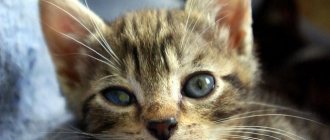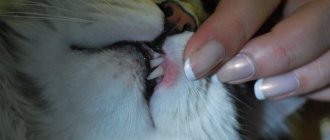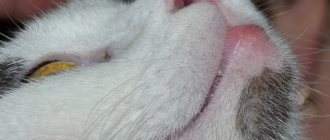When your pet feels unwell, it will not be able to tell its owner how it is feeling. It is necessary to monitor the external condition and behavior of your furry friend daily. Pets are often the target of blepharitis. In cats, this is a fairly common disease of the mucous part of the eye. If you do not respond to lacrimation, the contaminated part of the mucous membrane, you can get serious complications that will result in partial loss of vision and absolute blindness.
Blepharitis in cats: symptoms and treatment
The concept of blepharitis in veterinary medicine
Blepharitis is inflammation of the eyelids. The disease is common to all domestic animals, from dogs to hamsters. Cats are no exception.
Pet owners often confuse blepharitis with ordinary conjunctivitis, which can be treated on their own. However, the use of external solutions, washing with herbal decoctions and applying ointments do not bring the desired result, but, on the contrary, complicate the situation. The animal's condition is deteriorating day by day. In order to diagnose blepharitis in a timely manner, at the slightest suspicion of eye disease, you should see a veterinarian. With prompt intervention and properly selected treatment, this disease is eliminated quite quickly.
Blepharitis is inflammation of the eyelids
Keratitis
Keratitis is an eye disease in cats with inflammation of the cornea. Essentially, the cornea is a lens, the main function of which is to work with light; without it, a cat cannot see.
Keratitis occurs due to:
- Congenital anomalies;
- Injuries (eye bruises, penetrating wounds);
- Uveitis (inflammation of the choroid of the eye);
- Luxation (displacement) of the lens;
- Cataracts.
Symptoms of keratitis:
- Photophobia;
- Blepharospasm (the eye is constantly squinted);
- Swelling of the eye;
- Cloudiness of the cornea (it becomes dull, not shiny, as before the disease);
- Vessels are visible in the eye;
- Exudation (tears around the eyes, and later mucus and pus).
Diagnosis of the disease is carried out by a veterinary ophthalmologist. Specific diagnostic techniques are:
- Biomicroscopy of the eye
- Bacterioscopic examination
- Flurescein test (a special dye is dropped into the eye; injuries and tears in the cornea are stained).
Treatment of keratitis includes, first of all, treatment of the underlying disease, if there is one (infection, for example); for bacterial keratitis, antibiotics are prescribed (locally and/or systemically); if the integrity of the cornea is damaged, microsurgical treatment is recommended.
Types of blepharitis
There are several varieties of this disease, depending on the form of the disease and the causes of the lesion. Highlight:
- anterior, in which only the edge of the eyelids along the growth of the eyelashes is affected;
- in the posterior case, the meibomian glands are affected;
- angular affects the mucous corners of the eyes.
Table. Main types of blepharitis
| No | View | Description |
| 1 | Simple | It is characterized by redness of the eyelid and thickening at the edges. Purulent discharge accumulates in the corners of the eye. Meibomian glands expand |
| 2 | Scaly | The eyelid is subject to severe swelling and redness. Purulent inflammation forms. White fluid accumulates in the corners of the eyes. Scales appear along the eyelash line, reminiscent of dandruff. Very often complicated by conjunctivitis |
| 3 | Ulcerative | Develops along with the purulent process. Ulcers affect the roots of the hair. The eyelids turn red and swell. Yellowish dandruff appears. When the ulcers are affected, a bleeding ulcer appears. In the absence of a proper response, the development of various pathogens is possible |
| 4 | Demodectic | The cause of this disease is tick infection. The disease is possible due to a weakened immune system. Inflammation appears in the eyelid area. This form is difficult to diagnose and difficult to treat. Most often ends with surgery |
| 5 | Allergic | Redness and swelling of the eyelids, severe itching, aversion to light, lacrimation. The cat behaves restlessly, rubbing its eyes with its paw and on the furniture. Most often occurs due to poor diet or contact with chemicals. |
| 6 | Meibomian | Settles in the meibomian glands. The eyelashes stick together and yellow pus forms on them. A thick white substance and mucus appears in the corners of the eyes |
| 7 | Phlegmonous | Unilateral form of blepharitis. Accompanied by high temperature. There is pus in the corners of the eyes. The tissue on the eyelids becomes scarred. In the absence of a proper response, necrosis occurs |
Video - First signs of eye disease in dogs and cats
Possible complications
Eye diseases have not spared our smaller brothers either. Blepharitis in dogs is quite common. The disease is an inflammation of the ciliary edge of the eyelids and is accompanied by swelling, redness and itching. It can be complicated by inflammation of the so-called meibomian glands - small glands on the edges of the eyelids that produce an oily secretion.
The disease can be complicated by conjunctivitis, keratitis, and blurred vision. And if unfavorable, it leads to complete blindness. In this article we will look at the causes, types, main symptoms, as well as methods of treatment and prevention of this disease.
Causes of the disease
There are many reasons for the development of blepharitis. They are divided into two large groups:
- Infectious blepharitis is an inflammation of the eyelids caused by a bacterial infection, as well as fungal or mite-borne microorganisms.
- Non-infectious - can be congenital, traumatic, allergic. It may have another origin.
An advanced, chronic form of blepharitis can cause fusion and deformation of the eyelids, follicular and purulent conjunctivitis, dry conjunctiva, deterioration, partial or complete loss of vision.
Causes of blepharitis
There are many factors that lead to inflammation of the eyelid margin in pets.
- Among the most common causes are burns, including chemical ones.
- If your pet has recently taken any medications to treat another condition, the medications may have caused this reaction in the eyes.
- Incorrectly selected food can also lead to similar diseases.
- But the most common cause is various mechanical damage to the cornea or eyelids.
- If your cat often goes outside, then you shouldn’t rule out a fungal infection.
- Very often, inflammation appears against the background of renal failure.
In any case, blepharitis does not occur just like that, but is a consequence of serious problems with the pet’s health.
Incorrectly selected food can cause the development of eye diseases in cats.
Going to the veterinarian is not only about prescribing treatment. The doctor must find out the cause in order to prevent relapse in the future. The veterinarian checks whether the inflammation is due to:
- parasitic infestations;
- disturbances in the functioning of the endocrine system;
- autoimmune diseases;
- dysfunction of the sebaceous glands.
Depending on the cause of blepharitis, the symptoms of this disease also differ. Very often, correctly identified symptoms allow you to quickly find out the cause, eliminate the irritating factor and subsequently protect the animal from trouble.
Cataract
Cataract is a rare disease in cats (usually older cats), which consists of clouding of the substance and capsule of the lenses of the eyes.
The most common cause of this eye disease in cats is age-related changes in the lens, but cataracts can also be caused by a chronic infectious process, endocrinological diseases (diabetes mellitus), trauma, and intoxication. And with this disease it is not at all necessary that the eye become inflamed.
In the early stages, it is almost impossible to notice cataracts in a cat, since its main manifestation – decreased vision – is at first well compensated by the cat’s excellent sense of smell and hearing; in addition, some of the functions are taken over by the second eye. The second symptom - when the owner himself sees a “white spot in the eye” - appears when the disease has already developed quite strongly.
In order to distinguish cataracts from other cat eye diseases, at the appointment the doctor will carefully interview the owner, examine the sick cat, and perform ophthalmoscopy and biomicroscopy.
After making a diagnosis and determining the stage of cataract (initial, immature, mature, overmature), the doctor will determine a treatment strategy. This is mainly the treatment of the underlying disease (diabetes control, for example), drugs aimed at improving local metabolic processes. All this makes it possible to preserve vision for as long as possible. If the problem is long-standing and vision is seriously impaired, then only surgical intervention will help.
Prevention of the disease is compliance with the conditions for keeping cats, regular medical examination of patients over eight years of age.
Symptoms of blepharitis in cats
Symptoms vary depending on the type of disease. In 80% of cases, veterinarians are faced with redness of the eyelid and its inflammation. Clear or purulent discharge appears in the corners. The pet is nervous and tries to scratch the inflamed area. Such actions are aimed at eliminating itching. Gradually, the size of the eyes begins to decrease, the pet is limited in the viewing angle.
Advanced blepharitis
Against the background of blepharitis, conjunctivitis often begins to develop. Depending on the expression of symptoms, you can understand how long the disease lasts.
Purulent discharge from blepharitis in cats
But, in addition to standard symptoms, there are also specific manifestations. For example, if we are talking about a fungal disease. Cat owners note that against the background of this disease they experience eyelash loss and baldness in the eye area.
If the cause of the disease is autoimmune processes, blistering formations can be found on the cat’s body. In such a situation, a biopsy is required to make a correct diagnosis.
Blistering formations in blepharitis
When inflammation is caused by infection, this is indicated by the animal's painful condition. The cat becomes lethargic, apathetic, eats and drinks practically nothing. As the disease progresses, the animal's body begins to feel feverish. In case of infection, antibacterial therapy should be started immediately.
Veterinarians often encounter scaly blepharitis. With this type, the eyelids turn red and swelling spreads. The edge of the eyelid thickens and becomes dense. Against the background of this process, the shape of the eyes narrows. Gray small scales form in the eyelash growth area, which affect eyelash loss. If the scales begin to fill with pus, then the disease develops into an ulcerative condition. This disease develops much faster. The wounds begin to scar, and the eyelid literally turns in the opposite direction.
Treatment of cataracts in cats
Such a dangerous disease as cataracts (or clouding of the lens) requires immediate contact with a veterinarian, who will choose treatment tactics, determine its duration and select medications.
Most often, owners of older animals turn to a specialist with this problem. The reason for the development of the disease is a decrease in the water level in the lens, where cholesterol, protein that cannot be dissolved, and other substances begin to be deposited.
Sometimes cataracts are caused by:
- diabetes;
- severe injuries suffered by the pet;
- poisoning
Diagnosis of blepharitis
The owner of the animal can easily notice the symptoms of blepharitis on his own, at home. But for an accurate diagnosis you need to see a veterinarian.
If you suspect blepharitis, you should immediately consult a veterinarian
Proper inspection requires special equipment. The veterinarian's office should have a slit lamp. The doctor examines the animal and, if possible, collects a complete medical history. In the initial stages of blepharitis, it is necessary to exclude other diseases whose symptoms are similar. The examination begins with an assessment of the general condition of the animal and the degree of damage to the eyelids. If the damage is significant, symptomatic treatment is prescribed, which must be started immediately to preserve the cat’s vision. If the doctor suspects a fungal or infectious nature of the lesion, scrapings are taken from the inflamed area of the eyelids. A complete blood test is required to assess the cat's condition.
If it is impossible to identify the cause by examination, the eyelid tissue is taken for a biopsy. After the test results have been received, the doctor makes a diagnosis and develops a treatment regimen. It is necessary to see a veterinarian once a week to assess the animal’s condition and make possible changes to the regimen.
If a disease is suspected, a general blood test is required to assess the cat's condition.
Conjunctivitis
The conjunctiva is a thin, normally transparent tissue that lines the eyelids from the inside and the eyeball from the outside. Its inflammation is called conjunctivitis. This process occurs in response to:
- Trauma (scratch by another cat’s claw, self-traumatization, entry of a foreign object (sand, wood chips, plant seeds);
- Development of infection (rhinotracheitis, calicivirosis, chlamydia, mycoplasmosis);
- Chemical exposure (contact burns of the conjunctiva or exposure to vapors of certain chemicals can lead to conjunctivitis);
- Autoimmune process;
- Pathology of the structure of the eye (entropion, eversion of the eyelids).
Conjunctivitis manifests itself as edema (swelling) of the eyes, hyperemia (redness), lacrimation, such an eye will definitely hurt. There will be traces of discharge around the eyes, and the fur will be glued together.
Photo of eye disease in cats: conjunctivitis
Treatment of conjunctivitis involves making an accurate diagnosis at the first stage, and only after the doctor knows exactly what caused the inflammation, he will be able to give precise recommendations on what to do. Conjunctivitis is treated with local remedies (drops, ointments, gels containing antibiotics, non-steroidal anti-inflammatory drugs, hormonal drugs) and systemic drugs (tablets, injections).
Treatment
Depending on the degree of development of the disease, its cause and the type of blepharitis itself, an individual treatment method is prescribed. Most often, approaches are symptomatic or complex.
Symptomatic treatment is aimed at eliminating symptoms. Very often, such a regimen is prescribed if the animal has received the disease as a result of mechanical damage. If the cause is an infection, fungus, or other problems related to the pet’s health, then comprehensive treatment is prescribed. When the case is advanced, the doctor will suggest surgical intervention to preserve the animal’s vision and save it from suffering.
Depending on the degree of development of the disease, cause and type, an individual treatment method is prescribed
When a microorganism becomes the cause of the disease, a course of antibiotic therapy is prescribed. If a subcutaneous tick is detected in the body of an animal, three-time vaccination is prescribed with intervals of 15 days. Additionally, a fungicidal ointment is used to destroy microsporia.
You can read more about antibiotics for cats in a special article on our website.
Antibiotics are used both in the form of ointments and in the form of injections. But not all treatment can be carried out by the owner at home. Several times a month you will have to visit the veterinarian to administer antibacterial emulsions and suspensions to the affected area of blepharitis.
With the permission of a doctor, you can use traditional medicine methods. These are lotions, oil complexes, habitats, homemade drops.
With the permission of a doctor, you can use traditional medicine methods
With such an integrated approach, rest, proper nutrition and avoidance of contact with external irritants (no street walks), the animal will recover in a matter of days, and after a month it will completely forget about the illness it experienced.
Medications
In the treatment of blepharitis, veterinarians insist on the use of medications. Thanks to medications, you can achieve a quick effect without possible complications.
- To wash the eyes and remove crusts, use a mixture of petroleum jelly, soda and warm water. After mixing the ingredients in equal proportions, soak a cotton swab in the solution. Carefully treat the cat's eyes, removing crusts and scales along the way.
- Most often, veterinarians prescribe syntomycin emulsion. It relieves inflammation and prevents redness. Along with the emulsion, tetracycline and yellow-mercury ointment (one percent) have the same effect.
- Rinsing the animal's eyes with a salt solution will be an excellent remedy for ulcers.
- Iris eye drops prevent the onset of complications such as conjunctivitis. The frequency of use depends on the body weight and age of the animal.
- In the first week of treatment, veterinarians advise purchasing a special protective collar that is fixed around the neck. This will prevent your animal from scratching its eyes.
Eye drops "Iris"
Homemade eye washes
Every day, several times a day, it is necessary to clean the eye area from pus, crusts, and mucus. Not only medicinal solutions are suitable for this, but also herbal decoctions. The effectiveness of these solutions will depend on proper preparation.
- Chamomile and calendula decoction. 2 teaspoons of dried flowers should be poured with boiling water in an amount of 250 ml. Cover the container with a lid and leave for 15 minutes. The broth is filtered through multilayer gauze. Can only be used after cooling.
- Brew weak black tea. Cool the solution and strain it. Rub the animal's eyes.
- A mixture of dry sage and St. John's wort should be poured into 250 ml of boiling water. Let it brew for 15 minutes. Rinse eyes after cooling.
A decoction of chamomile and calendula is used to wash the eyes for blepharitis.
Washing procedure
In addition to the correct preparation of the product, it is important to approach the procedure itself correctly. Otherwise, you risk causing harm.
- Wash your hands thoroughly and treat with antiseptic.
- Adjust the time so that the cat is as relaxed as possible and not in a state of activity.
- Prepare the required solution in advance and cool it.
- Take a clean gauze pad. Lightly moisten it in the broth.
- Start wiping the eye area from the ear to the nose, trying to get the water into the inner part of the eyelid. You should not press, the movements should be light and pleasant.
- Wipe the treated area with dry gauze or a napkin.
Important! A new, clean cotton swab is used for each eye.
If after using the decoction you notice that the situation has worsened sharply, you should visit a veterinarian.
Use a new, clean cotton swab to wipe each eye
Correctly selected posture during the procedure will provide you with the desired result. Wrap the cat in a diaper or towel and lay it on its back. It is advisable for the animal to sit on your lap. Try to keep the light out of the cat's eyes, otherwise she will squint and the procedure will not bring the desired results.
Try not to touch the cornea of the eye, this is the most painful area with blepharitis. To consolidate the result, you can rinse your eyes with a syringe.
Video - How to wash a cat's eyes?
Symptoms and treatment of eye diseases in cats with photos
If a cat’s eye (or both at once) is red, there may be several explanations for this:
- diseases associated with structural changes in the organ;
- viral or bacterial diseases;
- allergy;
- mechanical damage (injury).
What should you do if your cat’s eye hurts, becomes swollen and watery? Many people immediately take their pet to the veterinarian. This decision is the only correct one, since banal itching and the onset of discharge can become heralds of diseases such as blepharitis and glaucoma. Even untreated conjunctivitis leads to serious complications. This article will help you understand whether you should take your pet to the doctor.
Painful sensations in the eye of a kitten or an adult animal and blurred vision are a common problem. This is often due not only to a lack of proper care on the part of the owner, but also to a hereditary predisposition.
There are many reasons for the occurrence of one or another ophthalmological disease - these are:
- penetration of infection into the pet’s body;
- general weakness caused by decreased immunity;
- metabolic disorder;
- infection by parasites, etc.
You should contact your veterinarian as soon as you notice the following characteristic signs:
- the eye began to water, opaque discharge appeared;
- the eyelids began to swell;
- a white or bluish film has appeared;
- the lens has become cloudy.
You shouldn’t hope that everything will go away on its own, nor should you think that you can diagnose and prescribe the necessary medications yourself - only a doctor knows how to treat eye diseases in cats.
It is important to contact a specialist on time - every lost day increases the risk of complications and deterioration of the pet’s condition.
So if you are not indifferent to the fate of the one you have tamed, you simply must take him to the nearest veterinary clinic when the first signs of illness are detected.
Most often in small kittens or older individuals there are:
- Damage to the nasolacrimal ducts
The reason for this unpleasant phenomenon for both the animal and its owner is the presence of adhesions in the nose. Every owner can recognize this disease by just carefully examining the pet’s face.
Signs of illness are the occurrence of profuse lacrimation, constant wetting of the eyes and fur around them, and a change in its color.
The most effective and efficient method of treating a pet may seem cruel to the animal, but its use is necessary to improve its well-being - the doctor probes the nasolacrimal ducts using catheters through which a special solution is released. Penetrating into the cavity, it acts on adhesions, softening them and removing them naturally.
- Follicular conjunctivitis
Opaque discharge is a symptom of another common disease that affects the conjunctiva, which almost covers the eye. In the first case, the eye becomes wet and sticks together due to an inflammatory process that affects not only the upper eyelid, but also the lymphatic follicles - they are visible to the owner in the form of red lumps.
In this case, symptoms such as the appearance of a cloudy film on the eyeball, purulent discharge, and sometimes the appearance of sensitivity and fear of bright light are observed.
Diagnosis should be entrusted to an experienced doctor, under no circumstances attempting to treat the animal with folk or improvised means.
Most often, veterinarians resort to surgery followed by drug treatment. It sounds unpleasant, but this is the only way to help your pet.
The cause of the disease is contamination of the eye with foreign particles and resulting irritation of the mucous membrane. Signs that the owner may note are the appearance of redness, swelling of the eyelid and the secretion of mucus (catarrh).
Comparing this form with the one given above, it is worth noting its relative harmlessness - the treatment does not require surgical intervention, and complications can only appear if the owner of the cat does not take care of his animal. This circumstance does not eliminate the need to see a doctor - the sooner you show your pet to a veterinarian, the faster he will recover.
- Phlegmonous conjunctivitis
A list with symptoms and treatment of common eye diseases in cats cannot do without mentioning this type - one of the most severe. When it occurs, not only the conjunctiva is damaged, but also the tissue surrounding the eyeball.
The reasons are the same as in the cases discussed above - injury to the mucous membrane by foreign bodies, which caused a serious inflammatory process. The following symptoms are characteristic: severe swelling of the connective membrane and edema of the subconjunctival tissue, damage to both the upper and lower eyelids, dryness of the protruding surface of the conjunctiva and its bleeding at the slightest mechanical impact. The animal may develop a fever.
Only a doctor can tell how to treat this eye disease in cats. Most often, the veterinarian prescribes lotions with a solution that has an astringent effect, rinsing with a solution of hydrogen peroxide and applying ointment. During treatment, your pet needs to be bandaged so that it does not injure the cornea and cause a new infection.
This disease is associated with an inflammatory process that affects the edges of the eyelids due to a lack of vitamins, dysbacteriosis, irritation by a foreign body or exposure to an infection. Signs in this case are redness and swelling, discharge of pus, severe itching that prompts the animal to scratch its eyes, loss of eyelashes and the appearance of ulcers.
The treatment prescribed by a specialist may include regular washing with drops for animals (“Iris” or “Conjunctivet”), a course of “Gamavita” intramuscularly and treatment of the eyelids with special ointments.
Blepharitis refers to inflammation of the edges of the eyelids. There are several types of the disease. The most common are simple (scaly), ulcerative, and meibomian.
There are many causes of blepharitis in cats:
- Viruses and bacteria, most often pyogenic cocci.
- Helminthic infestations.
- Subcutaneous mites. In this case, in addition to the eyelids, the neck and face of the animal are affected.
- Pathogens (fungi) of trichosporia and microsporia.
- Allergic reaction of the body to food, pollen, etc.
- Eye injuries received during a fight or as a result of self-scratching.
- Seborrhea. When the functions of the sebaceous glands are disrupted, dandruff and scales appear on the eyelids.
- Autoimmune and endocrine pathologies.
- Violation of hygiene standards.
And this is not a complete list of factors that provoke such an unpleasant eye disease as blepharitis.
Beautiful cat eyes can get sick not only from curiosity, but also for a number of other reasons:
- Pathogenic microflora. Penetration of viruses and cocci (strepto- and staphyllo-) into the body.
- A parasitic infection of the body that also affects the eyelids. Most often the culprit is a subcutaneous mite.
- Fungal agent, causative agent of lichen.
- Allergic reaction. Sometimes it is impossible to predict which food or household item will become an allergen for your pet.
- Trauma leading to infection.
- Seborrhea is a dysfunction of the sebaceous glands and the appearance of dandruff, including on the eyelids.
- An autoimmune disease that causes complications in the eyes.
- Endocrine disorders.
- Surgery to transfer the ducts of the salivary glands.
Feline surgeons perform countless surgeries every year because a cat's body doesn't always work as well as it looks. For example, a pet may develop insufficient function of the lacrimal glands, followed by dry eye syndrome. This condition is painful for a cat - the eye hurts, it dries out, as if sand is buried under the eyelids. Regularly instilling drops into a cat is problematic, and the owner doesn’t have that much time.
Therefore, the owner is offered to perform a simple operation on the cat, which will “move” the salivary glands to where the lacrimal glands cannot cope. But drool is much more aggressive than tears. They will not only moisturize, but will also begin to break down with their enzymes everything that gets in their way. Therefore, unfortunately, the cat still cannot avoid eye problems after such an operation.
The cause of the pathology can be congenital cystic formations in animals. In some breeds (Persians, Burmese and Himalayan cats), the pathology can develop against the background of a hereditary disease (complete closure of the eyelids). This causes meibomian blepharitis. Ectropion, which often affects Persians and Himalayans, causes inflammation of the eyelids in these breeds of animals.
We invite you to read: Features of purchasing and keeping a Thai cat
Eye diseases in cats are a pressing problem for breeders and lovers of these animals. The eyes of cats are an anatomically quite complex organ, allowing them to see perfectly not only in daylight, but also at night. At the same time, this organ is easily vulnerable and susceptible to various diseases. Cats' eyes react with inflammatory reactions to any infections in the body, being a definite indicator of health.
After all, if a cat’s eyes fester, this is not a harmless symptom. This is a manifestation of quite serious diseases that require urgent and adequate treatment.
The causes of suppuration in the eyes of a cat can be inflammatory processes in the eyes themselves and general diseases of the body.
Purulent discharge is an inflammatory exudate containing infectious agents (bacteria, viruses), protein, leukocytes and other components formed as a result of a response to infection. What eye diseases in cats are accompanied by purulent exudate?
Red eye syndrome is a characteristic sign of health problems in an animal. Often this phenomenon is accompanied by discharge from the eyes. If the owner does not respond in a timely manner and the animal does not receive the correct treatment, this can lead to unpleasant consequences.
Causes and treatment
If red eyes in a domestic cat are observed for a long time, and the owner does not take any action, this can lead the animal to blindness. Therefore, if the eye is damaged, it is advisable to quickly show the cat to the doctor.
Prevention
According to statistics, about 20% of furry pets suffer from blepharitis. And only 7% of them are diagnosed with this disease and treated in accordance with the recommendations of the veterinarian. Other animals either cope with such a scourge on their own or lose their sight. It is important to prevent the disease in your pet so as not to face a complex treatment process in the future.
- Vaccination. Don't forget about your pet's annual vaccination. It will protect your cat from trichophytosis and various viral diseases.
- Walks. To avoid becoming a victim of bacteria and subcutaneous mites, you need to carefully choose places for walking. Try to minimize your pet's contact with street animals.
- Owner hygiene. Wash your hands thoroughly after going outside, and do not let the animal come into contact with outer clothing and shoes.
- Pet hygiene. Wash your cat once a month with special anti-tick shampoos, especially in the spring and summer.
- Nutrition. Don’t forget that proper nutrition is the key to a strong immune system, which will save you from many diseases. Your cat's diet should be balanced, healthy, and moderate. Think about how well the food is chosen for your pet. In the spring and summer, it is worth resorting to vitamin supplements.
Inflammation of the eyelids in cats
Blepharitis: Which breeds are prone to it?
Our beloved Persians, Himalayan and Burmese cats most often suffer from eye diseases. Unfortunately, for the above breeds, this is a hereditary disease in which the eyelids cannot close completely. As a result, the eye is constantly under tension, which leads to irritation. Against the background of this feature, dermatitis, inflammation of the eyelid, conjunctivitis, and, finally, blepharitis appear.
In order to prevent the development of such a disease, wipe your cat's eyes several times a week with a decoction of medicinal herbs, such as chamomile or calendula.
A breed such as the Sphynx has a congenital bend in the eyelid, which occurs due to improper formation of epithelial tissues during the embryonic period. For this reason, the cat suffers from rubbing its eyelids against each other. Such cases, unfortunately, are the most difficult. If blepharitis occurs in such eyes, the only way to combat the disease is through surgery.
Protective cap for cats against eye scratching
Relapses of the disease: how to avoid?
By following the prescribed treatment, guided by preventive measures, you will never encounter the manifestation of blepharitis a second time. But relapse can occur:
- In case of an allergic reaction to a food product or external irritant.
- When a cat comes into contact with street animals.
- When various infections get into an open wound.
Important! If the symptoms of eyelid inflammation recur, you should not treat the disease yourself at home. Contact your veterinarian. It is quite possible that the cause of such an illness was a completely different factor than before, and it will require in-depth examination and different treatment.
Do not leave your pet without attention and proper treatment. After all, we are responsible for those we have tamed.











